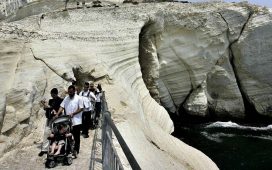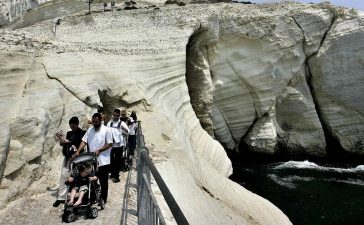University Communication and Marketing (UCAM) annually compiles a Year-in-Review highlighting both its general and research news and feature stories across campus during the course of the calendar year. From volcanic drone research in the Canary Islands to a ghostly mirror world to dinosaur respiratory infection, greenhouse gas warming and the impact of cannabis legalization on the stock market, scientists at The University of New Mexico conducted a wide variety of research in many areas with worldwide impact.
Below is a select list based on UCAM’s Newsroom Analytics of the top 2022 news stories highlighting a number of research accomplishments. Click on the headline to read the full story for each listing. The list below is in random order.
Ghostly ‘mirror world’ might be cause of cosmic controversy
New research suggests an unseen ‘mirror world’ of particles that interacts with our world only via gravity that might be the key to solving a major puzzle in cosmology today – the Hubble constant problem. Determining whether such a cosmological scenario exists is the question that researchers, including Francis-Yan Cyr-Racine, assistant professor in the Department of Physics and Astronomy at The University of New Mexico.
UNM’s VolCAN team makes history in Canary Islands
When an interdisciplinary team from The University of New Mexico was awarded a four-year, $1.5 million grant from the National Science Foundation in 2020, the goal was to develop novel, bio-inspired software and drones to measure and sample volcanic gases. One year later, the Project VolCAN team got a spectacular opportunity to do just that — and make history in the process by becoming what is believed to be one of the first research teams to collect uncontaminated gases from an active volcanic eruption.
Researchers discover first evidence indicating dinosaur respiratory infection
A group of researchers from around the country, including University of New Mexico Research Assistant Professor Ewan Wolff, discovered the first evidence of a unique respiratory infection in the fossilized remains of a dinosaur that lived nearly 150 million years ago. The study, “The first occurrence of an avian‑style respiratory infection in a non‑avian dinosaur,” was recently published in the Scientific Report.
Jupiter-like planet discovered through TESS and citizen scientist collaboration
Since 2010, Tom Jacobs, a former U.S. naval officer, has participated in online volunteer projects that allow anyone who is interested — “citizen scientists” — to look through NASA telescope data for signs of planets beyond our solar system. Now, Jacobs has helped discover a giant gaseous planet about 379 light-years from Earth, orbiting a star with the same mass as the Sun. The Visual Working Group alerted two professional scientist collaborators including Diana Dragomir, an assistant professor at The University of New Mexico and a co-author on the study.
Cannabis legalization decreases the stock market value of major pharmaceutical firms
Researchers from California Polytechnic State University and The University of New Mexico find that stock market investors predict cannabis legalization will reduce conventional pharmaceutical sales by billions of dollars. In a recent study, “U.S. Cannabis Laws Projected to Cost Generic and Brand Pharmaceutical Firms Billions,” published in PLOS One, Sarah Stith from the University of New Mexico’s Economics department and a co-author, studied how the stock market returns of publicly traded pharmaceutical firms responded to medical and recreational cannabis legalization events.
International team of scientists find many coastal cities worldwide vulnerable to sea level rise due to rapid land sinking
A team of international scientists has found that many densely populated coastal cities worldwide are at a high risk of extreme relative sea level rise as land sinks due to groundwater extraction and other industrial processes. The team of scientists, which included Eric Lindsey, assistant professor in the Department of Earth and Planetary Sciences at The University of New Mexico, processed satellite images of 48 of the largest coastal cities worldwide from 2014 to 2020 to measure land subsidence rates using a cloud-based processing system.
Technology: UNM researchers find Bitcoin mining is environmentally unsustainable
Taken as a share of the market price, the climate change impacts of mining the digital cryptocurrency Bitcoin is more comparable to the impacts of extracting and refining crude oil than mining gold, according to an analysis published in Scientific Reports by researchers at The University of New Mexico.
Explore or exploit: How our brain makes choices
People make countless choices every day. It may be a difficult, complex choice—whether to take the job in a new city or stay in a current position—or be as simple as choosing between visiting a new restaurant or going to an old favorite. Decision-making shapes our knowledge and our perceptions of the world around us. But what happens inside our brain when we make one choice or the other? Jeremy Hogeveen, assistant professor in the UNM Department of Psychology, details his search for answers in a new article published in the prestigious neuroscience journal Neuron.
Scientists find greenhouse gas warming likely cause of industrial-era sea level rise
An international team of scientists has developed an accurate record of preindustrial sea level utilizing precisely dated phreatic overgrowths on speleothems that provide a detailed history of Late Holocene sea-level change in Mallorca, Spain, an island in the western Mediterranean Sea. The results provide an unprecedented picture of sea level over the past 4,000 years, putting the preindustrial and modern global mean sea level (GMSL) histories in context. The collaboration involves several U.S. and international scientists, including University of New Mexico scientists Yemane Asmerom and Victor Polyak.
New study suggests using Cannabis can make you a nicer person
Investigators at The University of New Mexico analyzed the psychological functioning of healthy college students with varying levels of tetrahydrocannabinol (THC) in their urine. Compared to nonusers, young adults with recent exposure to cannabis scored significantly higher on standardized measurements of prosocial behaviors, empathy, and moral decision-making founded on principles of ensuring harmlessness and sense of fairness.
UNM biologists use zebrafish as model to understand loss of smell caused by COVID
The COVID-19 pandemic has prompted the search for animal models that demonstrate the symptoms observed in humans infected with SARS-CoV-2. New research from University of New Mexico Biology Ph.D. student Aurora Kraus and associate professor of Biology Irene Salinas have begun using zebrafish as a model for COVID-19 with emphasis on the loss of smell many people have reported as a symptom of the virus.
PAÍS Visualization Lab brings big data to life
The University of New Mexico (UNM) completed construction on its new Physics & Astronomy and Interdisciplinary Science (PAÍS) building, a $67 million project that is already changing the way research is conducted on campus. A project over 20 years in the making, the PAÍS facility houses the Department of Physics & Astronomy along with the new Interdisciplinary Science Cooperative (IS Co-op). Every detail within the 137,000-square-foot facility—from collaborative meeting spaces to labs with open floor plans—is dedicated to encouraging interdisciplinary education and research.
UNM research on Ancestral Pueblo fishing spotlighted in archaeological journal
There is a common misconception that Ancestral Pueblo people rarely ate fish. Research from Jonathan Dombrosky, adjunct assistant professor at The University of New Mexico Department of Anthropology, shows that not only did fish become a more common part of their diet but, like anyone who enjoys fishing, the bigger the fish, the better. The article recently chosen for the editor’s spotlight in the Journal of Archaeological Science is titled Body Size from Unconventional Specimens: A 3D Geometric Morphometrics Approach to Fishes from Ancestral Pueblo Contexts.
Native American student looks at research through traditional lens
Finding her niche from her traditional background to success has sometimes been a rocky road for Raven Longwolf Alcott. But now a senior looking forward to graduation next spring, she has negotiated the obstacles and found success at The University of New Mexico as a researcher and environmental activist.
UNM group designs rock-tapping remote control robot to detect potential slides
The University of New Mexico’s Smart Management of Infrastructure Laboratory (SMILab) has created a remote-controlled (RC) robot designed to detect potential rockslide danger. The robot, affectionately nicknamed “Brutus,” pinpoints damaged and unstable rocks for roadside safety inspectors, keeping them safely out of harm’s way during inspections.
Who to blame: UNM professor researches AI harm and culpability
Imagine your identity gets stolen or misconfigured online, resulting in serious personal damages. The cause was an error rooted in Artificial Intelligence (AI) technology, equipment with no face or name. So, who’s to blame? Is it the company that hosts the technology, the state who commissioned it, the worker who created a certain piece of code, or someone else altogether. This game of Clue is something that has had and will continue to have monumental consequences and questions for years to come. UNM Law Professor Sonia Gipson Rankin, however, is one step closer to finding out the answers.
New research by UNM scientists provides possible insights into the formation of Earth
A new study, conducted by scientists at The University of New Mexico, found ancient, primordial helium-3 leaking from the Earth’s core, suggesting the planet formed inside a solar nebula, stirring further debate among scientists. Now, scientific models of volatile exchange during Earth’s formation and evolution implicate the metallic core as a leaky reservoir that supplies the rest of the Earth with helium-3. The results also suggest that other volatiles may be leaking from the core into the mantle.
Migrants from south carrying maize were early Maya ancestors
New research published this week by University of New Mexico archaeologist Keith Prufer shows that a site in Belize was critical in studying the origins of the ancient Maya people and the spread of maize as a staple food. According to the paper South-to-north migration preceded the advent of intensive farming in the Maya region, published this week in Nature Communications and co-led by Prufer, excavations in Belize, along with ancient DNA analysis, indicate a previously unknown migration of people–carrying maize–from an area of South America northward to the Maya region.
UNM continental-scale helium study probes the deep structure of the Tibetan Plateau and the Himalayan plate collision
The Tibetan Plateau is a region about twice the elevation of the Colorado Plateau that was uplifted during the collision of the Indian and the Asian continental plates that is forming the Himalayan Mountains. Together they form the planet’s highest elevation region and an archetypal example of the processes of continent-continent plate collision. Using geochemical data gathered over nearly a decade, from 225 hot springs, scientists, including UNM Department of Earth and Planetary Sciences (E&PS) Professors Laura Crossey and Karl Karlstrom, have now mapped the subsurface boundary between the Indian and Asian continental plates.
UNM scientists’ part of NASA team to open Apollo-era lunar samples
Scientists at The University of New Mexico recently took part in the opening of ANGSA 73001, a drive tube lunar sample collected by NASA’s Apollo 17 mission that will allow scientists to study any gases that may reside in the container as well as lunar soil samples from the 50-year-old sample preserved in a core sample vacuum container (CSVC). UNM Research Scientist Charles “Chip” Shearer, science co-lead for ANGSA and research scientist at UNM’s Institute of Meteoritics (IOM) and a research professor in the Department of Earth & Planetary Sciences, has led this effort for the past 10 years.
NOTABLE NEWSMAKERS
UNM turns challenges into opportunities with 10 new research teams
Child abuse, mental health, food and housing insecurity, and language endangerment — the issues facing New Mexicans everyday can be seen from the streets of Las Cruces to the doorways of Raton. But 10 research teams at The University of New Mexico are turning those challenges into opportunities, by pursuing long-term, sustainable solutions.
UNM professor explains initial James Webb Space Telescope images
Recently, the James Webb Space Telescope (JWST), NASA’s largest and most powerful space science telescope, began transmitting incredible, never before seen images of distant stars, galaxies and planets down to Earth to the wonder and amazement of JWST mission officials, stargazers and astronomy buffs around the world. To learn more, UNM Department of Physics and Astronomy Professor Kevin Cahill discussed the images, the bending of light and the images people are seeing from the James Webb Space Telescope.
UNM doctoral candidate develops open-source GPU-capable fluid dynamics code
When Brian Romero began his doctoral research in the Advanced Fluids Lab, led by Professor Svetlana Poroseva at The University of New Mexico’s Mechanical Engineering Department, he quickly realized that the tool he needed to complete his work had not yet been developed. He needed a computational fluid dynamics solver capable of simulating supersonic flows with shock waves but couldn’t find one that he liked. That’s when Romero turned to UNM’s Center for Advanced Research Computing (CARC) and set out to construct the necessary tool.
Undergrad researchers search for answers in Neural Diversity Lab
Mubarak Hussain Syed, an assistant professor of Biology at The University of New Mexico, and his students, many of them undergraduates, are investigating the genetic and molecular mechanics regulating neural diversity ̶ from stem cells to neural circuits. The findings will help understand the fundamental principles of nervous system development and potentially to understand and treat neurodevelopmental disorders such as epilepsy, schizophrenia, ADHD, and autism.
UNM poised to become an epicenter for fossil collection with opening of Natural History Science Center
One of UNM’s many historical buildings has been given new life again – and it will serve as an educational resource to future scientists throughout our community. Situated at the southern edge of main campus, the Natural History Science Center (NHSC) is a collaborative space dedicated to introducing and researching the rich history of our Earth.










